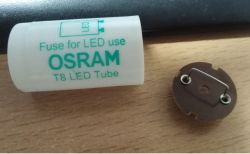Ok, tomorrow in the warehouse at 8 am I will buy an 18W LED lamp with such a starter in the set, put it in the place of the usual, put in place of the "normal" starter the one attached to the new LED lamp, turn the power on and off 20 times and ... I will speak . I admit that I haven't had these starters in my hand yet, but I believe in the distributor's info, because why not .....
Added after 1 [minutes]: He puts the link on it because some people don't believe in the existence of such a thing (beginning of the thread)
As I mentioned - tomorrow in the warehouse I will stock up and talk to the gentlemen about this disconnection of the ballast, in the end they give a 3-year warranty on such a "set".
Added after 16 [minutes]: https://www.elektroda.pl/rtvforum/topic2550714.html And then the next question arose
= only double-sided led tubes work with such starters
Added after 15 [hours] 7 [minutes]: Ok, so I replaced the fluorescent lamp. From the luminaire containing 36W traditional fluorescent lamp, ballast, starter and sockets - the fluorescent lamp and traditional starter were removed. An 18W T8 LED fluorescent lamp was inserted, an element called LED TUBE fuser was attached to the starter socket

Nothing else was done, the fluorescent lamp shines beautifully, turned on and off several dozen times in a few hours.
So to sum up: the element called "starter for LED" is a protection in the housing and with the legs of a typical starter (igniter). There is a 2A fuse inside my. Which, moreover, perfectly reflects its name on the box that I gave

On the leaflet attached to the fluorescent lamp (Spectrum LED Wojnarowscy) There is the following recommendation when replacing the fluorescent lamp in the luminaire I described: to save more energy, bridge the magnetic ballast (ballast) and disconnect the capacitor, the presence of a compensating capacitor can cause a significant increase in reactive energy consumption. THIS RECOMMENDATION.
If we have an electronic ballast - of course, as we know, the case looks quite different, We need to power the fluorescent lamp on one side, cables straight from the network.
The warehouse clerk claimed that there was a jumper in this "led starter", he partly lost the bet

. He also claimed that without interfering with the ballast, the fluorescent lamp would burn or not light (that I would not mention a similar statement from a colleague above) - he was also wrong. In addition - despite the fact that it is powered from one side - the fluorescent lamp in the system that I described can be inserted freely. There is a bridge on one side of the lamp, a short circuit between the legs. Thanks to this, through this bridge and the fuse (the "fuse" mentioned above) the power legs of the fluorescent lamps get both L and N.
It remains to measure how much energy less the luminaire will consume without a capacitor and ballast, but it's tomorrow.



